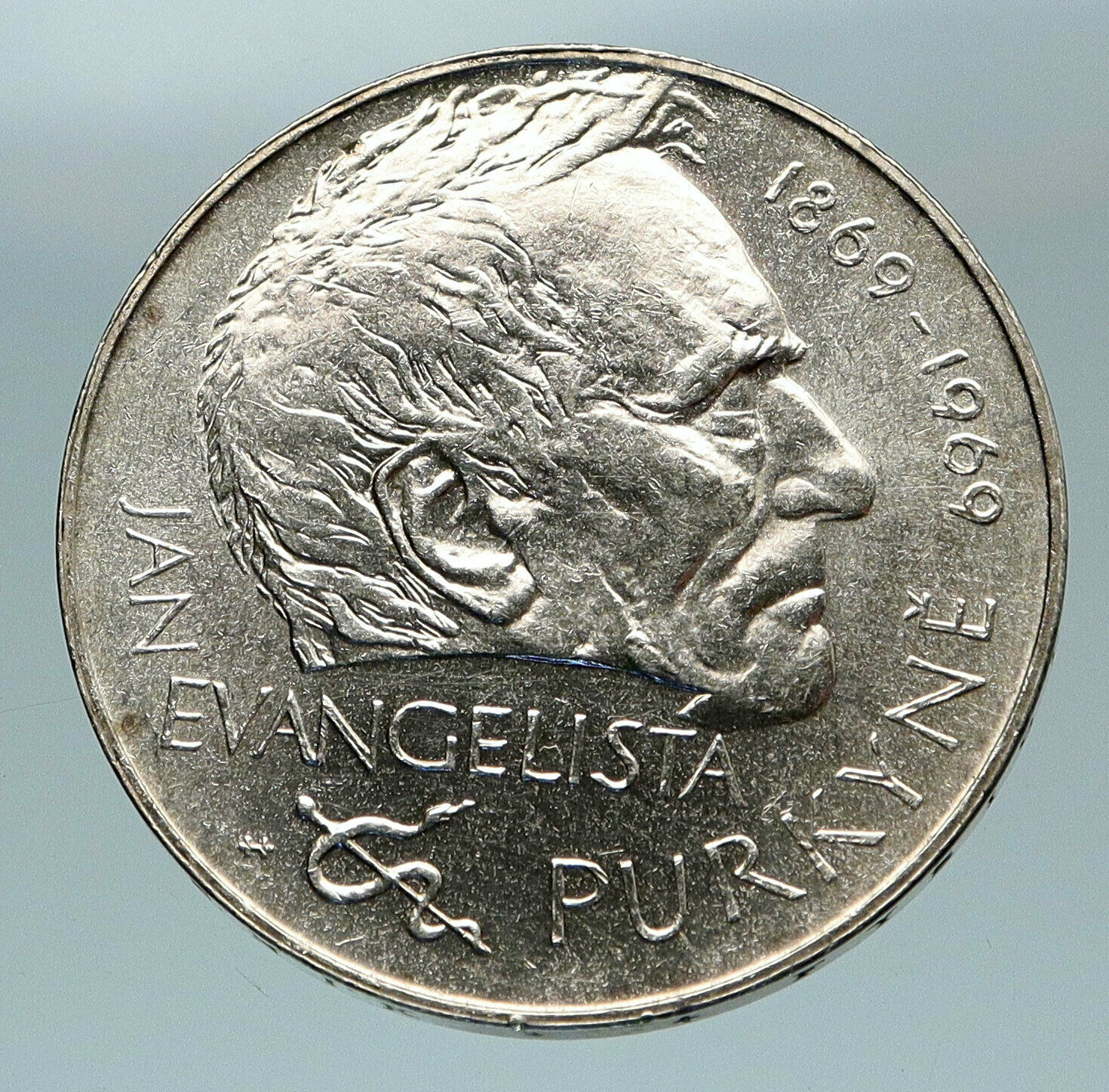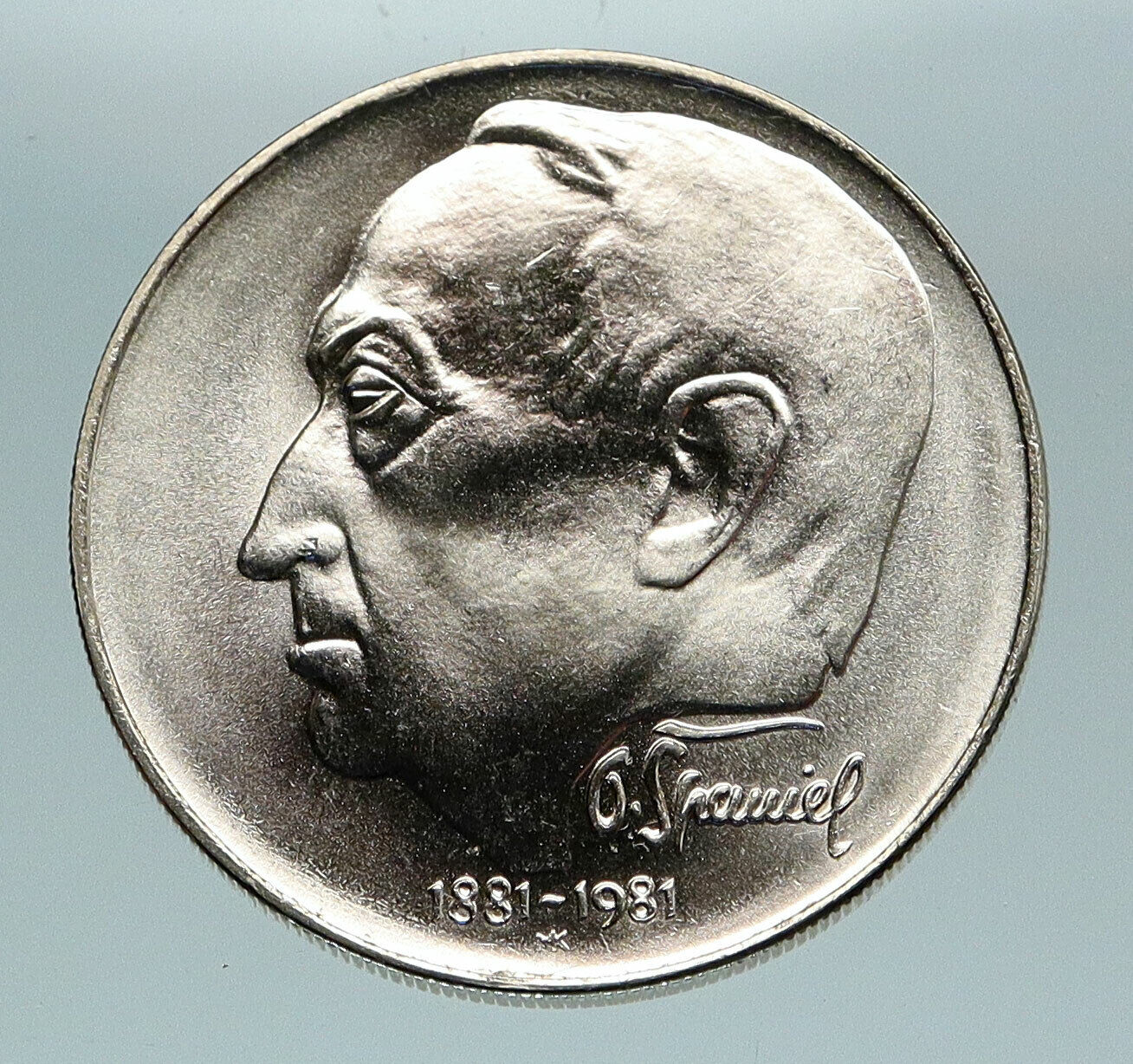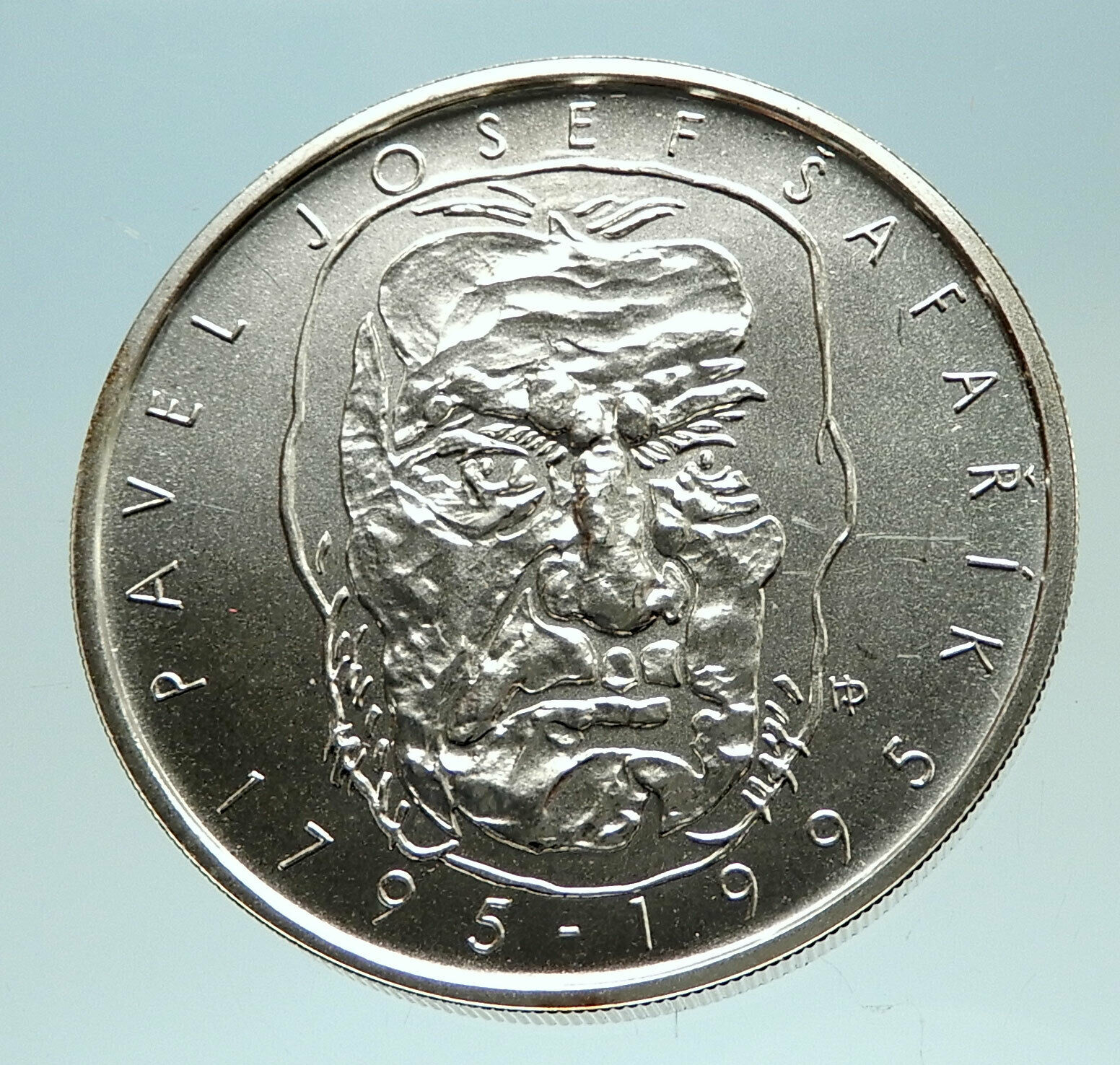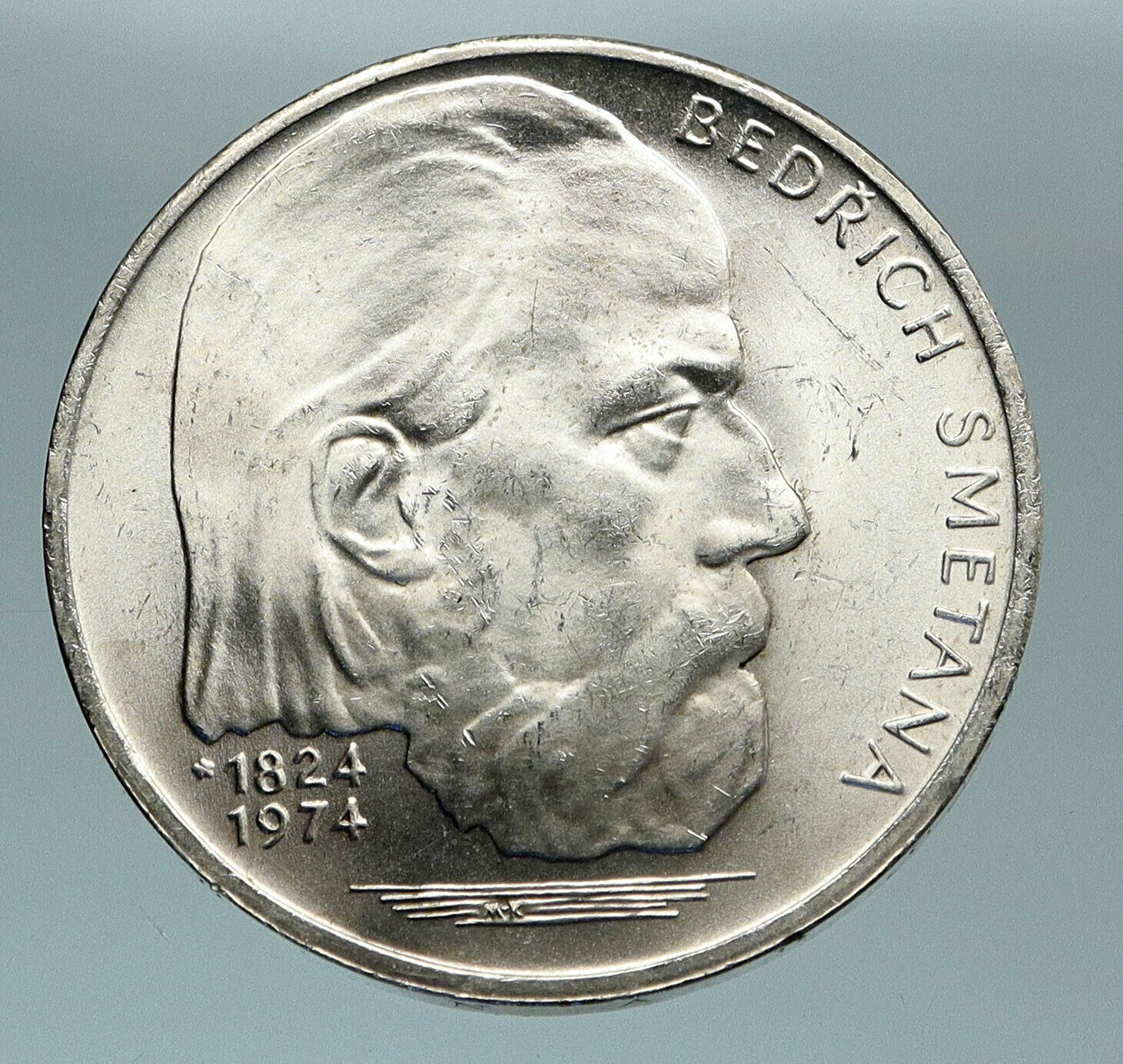|
Czech Republic – Czechoslovakia
700th Anniversary of Jihlava Mining
Privileges
1949 Silver 100 Korun 31mm (14.00 grams) 0.500 Silver (0.2251 oz. ASW)
Reference: KM# 29, Schön# 35 | Engraver: Otakar Španiel
REPUBLIKA ČESKOSLOVENSKÁ 1949, Czech Lion holding a Slovak shield with the name
of the state above the date.
700 LET HORNICKÝCH PRÁV O. ŠPANIEL, A miner with the denomination below.
You are bidding on the exact item pictured, provided with a Certificate of Authenticity and Lifetime Guarantee of Authenticity.
 Jihlava is a city in the Czech Republic. It has about 51,000 inhabitants. Jihlava is the capital of the Vysočina Region, situated on the Jihlava river on the historical border between Moravia and Bohemia, and is the oldest mining town in the Czech Republic, approximately 50 years older than Kutná Hora. The historic centre of Jihlava is well preserved and historically significant and is protected by law as an urban monument reservation. Jihlava is a city in the Czech Republic. It has about 51,000 inhabitants. Jihlava is the capital of the Vysočina Region, situated on the Jihlava river on the historical border between Moravia and Bohemia, and is the oldest mining town in the Czech Republic, approximately 50 years older than Kutná Hora. The historic centre of Jihlava is well preserved and historically significant and is protected by law as an urban monument reservation.
According to legend, silver was mined in Iglau as early as 799. King Ottokar I established a mint, and Iglau was granted extensive privileges already during these early times.
An old Slavic settlement upon a ford was moved to a nearby hill where the mining town was founded (ca. 1240) by King Wenceslaus I. In the Middle Ages the town was inhabited mostly by Germans (mostly from Northern Bavaria and Upper Saxony). Medieval mines surrounded by mining settlements were localized outside the walls of the medieval town (named Staré Hory).
In the era of the Hussite Wars, Jihlava remained a Catholic stronghold and managed to resist a number of sieges. Later at Jihlava, on 5 July 1436, a treaty was made with the Hussites, whereby the emperor Sigismund was acknowledged king of Bohemia.[3] A marble relief near the town marks the spot where Ferdinand I, in 1527, swore fidelity to the Bohemian estates.[3]
During the Thirty Years’ War Jihlava was twice captured by the Swedes. In 1742, it fell into the hands of the Prussians, and in December 1805 the Bavarians under Wrede were defeated near the town.[3] In 1860, it became the childhood home of Bohemian-Austrian composer Gustav Mahler, who retained his ties to the town until the death of both of his parents in 1889.
Until World War I the town was an important Austro-Hungarian Army military centre. In 1914, the First, Second and Third Battalions of the Moravian Infantry Regiment No. 81 (Bataillon des Mährischen Infanterie-Regiments Nummer. 81) and the Second Battalion of the Landwehr infantry regiment number 14 (II. Bataillon des Landwehr-Infanterie-Regiments Nr. 14) were the garrison troops.
After World War I the town constituted a German language island within Slavic speaking Moravia. This affected local politics, as it remained the centre of the second largest German-speaking enclave in the republic of Czechoslovakia (after Schönhengstgau/Hřebečsko). After the Czechoslovak Republic was proclaimed on 28 October 1918, the indigenous Germans of Bohemia and Moravia, claiming the right to self-determination according to the 10th of President Woodrow Wilson’s Fourteen Points, demanded that their homeland areas remain with the new Austrian State. The Volksdeutsche of Iglau relied on peaceful opposition to the Czech military occupation of their region, a process that started on 31 October 1918 and was completed on 28 January 1919. Unsuccessful in getting their right to self-determination recognized and incorporated into the new Czechoslovak state, many of the indigenous Germans instead took to more nationalistic politics. Thereafter extremist political figures like Hans Krebs, editor of the Iglauer Volkswehr newspaper, became prominent with the rise of Nazism and the Nazi occupation (1939–1945).
Until the end of World War II, Iglau was the centre of a distinctive regional folk culture reflecting hundreds of years of local customs. The local dialect of German was a unique branch of Mitteldeutsch. Musicians often used homemade instruments and original groups of four fiddles (Vierergruppen Fiedeln) and Ploschperment. Typical folk dances were the Hatschou, Tuschen and Radln. Peasant women wore old “pairische” Scharkaröckchen costumes with shiny dark skirts and big red cloths.
Most of Jihlava’s Jewish population was deported and killed due to the Holocaust in Bohemia and Moravia.[4]
After the end of World War II, starting from May 9, 1945, German-speakers were banned from using public transportation and were ordered to carry white armbands identifying them as Germans.[5] Following the Beneš decrees, the German-speakers were evicted from their homeland; it is estimated that hundreds died on the arduous trek to Austria.[6] The town was repopulated with Czech and Moravian settlers favored by the new Communist regime. After 1951, the town was the site of several Communist show trials, which were directed against the influence of the Roman Catholic Church on the rural population. In the processes eleven death sentences were passed and 111 years of prison sentences imposed. All the convicted persons were rehabilitated after the Velvet Revolution.
In protest against the Soviet occupation of Czechoslovakia in 1969 Evžen Plocek set himself on fire in the town marketplace in emulation of others in Prague. Today there is a memorial plaque to him.
Since the collapse of Communism in the 1990s the share of employment in agriculture has steadily declined. The industrial sector of the town now employs 65 percent of all workers.
 The Czech Republic also known by its short-form name, Czechia, is a landlocked country in Central Europe bordered by Germany to the west, Austria to the south, Slovakia to the east and Poland to the northeast. The Czech Republic covers an area of 78,866 square kilometres (30,450 sq mi) with a mostly temperate continental climate and oceanic climate. It is a unitary parliamentary republic, with 10.6 million inhabitants; its capital and largest city is Prague, with 1.3 million residents. Other major cities are Brno, Ostrava, Olomouc and Pilsen. The Czech Republic is a member of the European Union (EU), NATO, the OECD, the United Nations, the OSCE, and the Council of Europe. The Czech Republic also known by its short-form name, Czechia, is a landlocked country in Central Europe bordered by Germany to the west, Austria to the south, Slovakia to the east and Poland to the northeast. The Czech Republic covers an area of 78,866 square kilometres (30,450 sq mi) with a mostly temperate continental climate and oceanic climate. It is a unitary parliamentary republic, with 10.6 million inhabitants; its capital and largest city is Prague, with 1.3 million residents. Other major cities are Brno, Ostrava, Olomouc and Pilsen. The Czech Republic is a member of the European Union (EU), NATO, the OECD, the United Nations, the OSCE, and the Council of Europe.
It is a developed country with an advanced, high income export-oriented social market economy based in services, manufacturing and innovation. The UNDP ranks the country 14th in inequality-adjusted human development. The Czech Republic is a welfare state with a “continental” European social model, a universal health care system, tuition-free university education and is ranked 14th in the Human Capital Index. It ranks as the 6th safest or most peaceful country and is one of the most non-religious countries in the world, while achieving strong performance in democratic governance.
<img src="https://upload.wikimedia.org/wikipedia/commons/thumb/e/ed/Coat_of_arms_of_the_Czech_Republic.svg/85px-Coat_of_arms_of_the_Czech_Republic.svg.png" align="left" the="" czech="" republic="" includes="" historical="" territories="" of="" bohemia,="" moravia,="" and="" silesia.="" state="" was="" formed="" in="" late="" 9th="" century="" as="" duchy="" bohemia="" under="" great="" moravian="" empire.="" after="" fall="" empire="" 907,="" centre="" power="" transferred="" from="" moravia="" to="" přemyslid="" dynasty.="" 1002,="" formally="" recognized="" an="" imperial="" holy="" roman="" along="" with="" kingdom="" germany,="" burgundy,="" italy,="" numerous="" other="" territories,="" becoming="" 1198="" reaching="" its="" greatest="" territorial="" extent="" 14th="" century.="" beside="" itself,="" king="" ruled="" lands="" bohemian="" crown,="" holding="" a="" vote="" election="" emperor;="" prague="" seat="" periods="" between="" 17th="" hussite="" wars="" 15th="" driven="" by="" protestant="" reformation,="" faced="" economic="" embargoes="" defeated="" five="" consecutive="" crusades="" proclaimed="" leaders="" catholic="" church.=""
 Following the Battle of Mohács in 1526, the whole Crown of Bohemia was gradually integrated into the Habsburg Monarchy alongside the Archduchy of Austria and the Kingdom of Hungary. The Protestant Bohemian Revolt (1618-20) against the Catholic Habsburgs led to the Thirty Years’ War. After the Battle of the White Mountain, the Habsburgs consolidated their rule, eradicated Protestantism and reimposed Catholicism, and also adopted a policy of gradual Germanization. This contributed to the anti-Habsburg sentiment. A long history of resentment of the Catholic Church followed and still continues. With the dissolution of the Holy Roman Empire in 1806, the Bohemian Kingdom became part of the German Confederation 1815-1866 as part of Austrian Empire (1804 to 1867) and the Czech language experienced a revival as a consequence of widespread romantic nationalism. In the 19th century, the Czech lands became the industrial powerhouse of the monarchy and were subsequently the core of the Republic of Czechoslovakia, which was formed in 1918 following the collapse of the Austro-Hungarian Empire after World War I. Following the Battle of Mohács in 1526, the whole Crown of Bohemia was gradually integrated into the Habsburg Monarchy alongside the Archduchy of Austria and the Kingdom of Hungary. The Protestant Bohemian Revolt (1618-20) against the Catholic Habsburgs led to the Thirty Years’ War. After the Battle of the White Mountain, the Habsburgs consolidated their rule, eradicated Protestantism and reimposed Catholicism, and also adopted a policy of gradual Germanization. This contributed to the anti-Habsburg sentiment. A long history of resentment of the Catholic Church followed and still continues. With the dissolution of the Holy Roman Empire in 1806, the Bohemian Kingdom became part of the German Confederation 1815-1866 as part of Austrian Empire (1804 to 1867) and the Czech language experienced a revival as a consequence of widespread romantic nationalism. In the 19th century, the Czech lands became the industrial powerhouse of the monarchy and were subsequently the core of the Republic of Czechoslovakia, which was formed in 1918 following the collapse of the Austro-Hungarian Empire after World War I.
Czechoslovakia remained the only democracy in this part of Europe in the interwar period. However, the Czech part of Czechoslovakia was occupied by Germany in World War II, while the Slovak region became the Slovak Republic; Czechoslovakia was liberated in 1945 by the armies of the Soviet Union and the United States. Most of the three millions of the German-speaking minority were expelled following the war. The Communist Party of Czechoslovakia won the 1946 elections and after the 1948 coup d’état, Czechoslovakia became a one-party communist state under Soviet influence. In 1968, increasing dissatisfaction with the regime culminated in a reform movement known as the Prague Spring, which ended in a Soviet-led invasion. Czechoslovakia remained occupied until the 1989 Velvet Revolution, when the communist regime collapsed and market economy was reintroduced. On 1 January 1993, Czechoslovakia peacefully dissolved, with its constituent states becoming the independent states of the Czech Republic and Slovakia. The Czech Republic joined NATO in 1999 and the EU in 2004.
|





 Jihlava is a city in the Czech Republic. It has about 51,000 inhabitants. Jihlava is the capital of the Vysočina Region, situated on the Jihlava river on the historical border between Moravia and Bohemia, and is the oldest mining town in the Czech Republic, approximately 50 years older than Kutná Hora. The historic centre of Jihlava is well preserved and historically significant and is protected by law as an urban monument reservation.
Jihlava is a city in the Czech Republic. It has about 51,000 inhabitants. Jihlava is the capital of the Vysočina Region, situated on the Jihlava river on the historical border between Moravia and Bohemia, and is the oldest mining town in the Czech Republic, approximately 50 years older than Kutná Hora. The historic centre of Jihlava is well preserved and historically significant and is protected by law as an urban monument reservation. The Czech Republic also known by its short-form name, Czechia, is a landlocked country in Central Europe bordered by Germany to the west, Austria to the south, Slovakia to the east and Poland to the northeast. The Czech Republic covers an area of 78,866 square kilometres (30,450 sq mi) with a mostly temperate continental climate and oceanic climate. It is a unitary parliamentary republic, with 10.6 million inhabitants; its capital and largest city is Prague, with 1.3 million residents. Other major cities are Brno, Ostrava, Olomouc and Pilsen. The Czech Republic is a member of the European Union (EU), NATO, the OECD, the United Nations, the OSCE, and the Council of Europe.
The Czech Republic also known by its short-form name, Czechia, is a landlocked country in Central Europe bordered by Germany to the west, Austria to the south, Slovakia to the east and Poland to the northeast. The Czech Republic covers an area of 78,866 square kilometres (30,450 sq mi) with a mostly temperate continental climate and oceanic climate. It is a unitary parliamentary republic, with 10.6 million inhabitants; its capital and largest city is Prague, with 1.3 million residents. Other major cities are Brno, Ostrava, Olomouc and Pilsen. The Czech Republic is a member of the European Union (EU), NATO, the OECD, the United Nations, the OSCE, and the Council of Europe.  Following the Battle of Mohács in 1526, the whole Crown of Bohemia was gradually integrated into the Habsburg Monarchy alongside the Archduchy of Austria and the Kingdom of Hungary. The Protestant Bohemian Revolt (1618-20) against the Catholic Habsburgs led to the Thirty Years’ War. After the Battle of the White Mountain, the Habsburgs consolidated their rule, eradicated Protestantism and reimposed Catholicism, and also adopted a policy of gradual Germanization. This contributed to the anti-Habsburg sentiment. A long history of resentment of the Catholic Church followed and still continues. With the dissolution of the Holy Roman Empire in 1806, the Bohemian Kingdom became part of the German Confederation 1815-1866 as part of Austrian Empire (1804 to 1867) and the Czech language experienced a revival as a consequence of widespread romantic nationalism. In the 19th century, the Czech lands became the industrial powerhouse of the monarchy and were subsequently the core of the Republic of Czechoslovakia, which was formed in 1918 following the collapse of the Austro-Hungarian Empire after World War I.
Following the Battle of Mohács in 1526, the whole Crown of Bohemia was gradually integrated into the Habsburg Monarchy alongside the Archduchy of Austria and the Kingdom of Hungary. The Protestant Bohemian Revolt (1618-20) against the Catholic Habsburgs led to the Thirty Years’ War. After the Battle of the White Mountain, the Habsburgs consolidated their rule, eradicated Protestantism and reimposed Catholicism, and also adopted a policy of gradual Germanization. This contributed to the anti-Habsburg sentiment. A long history of resentment of the Catholic Church followed and still continues. With the dissolution of the Holy Roman Empire in 1806, the Bohemian Kingdom became part of the German Confederation 1815-1866 as part of Austrian Empire (1804 to 1867) and the Czech language experienced a revival as a consequence of widespread romantic nationalism. In the 19th century, the Czech lands became the industrial powerhouse of the monarchy and were subsequently the core of the Republic of Czechoslovakia, which was formed in 1918 following the collapse of the Austro-Hungarian Empire after World War I. 




